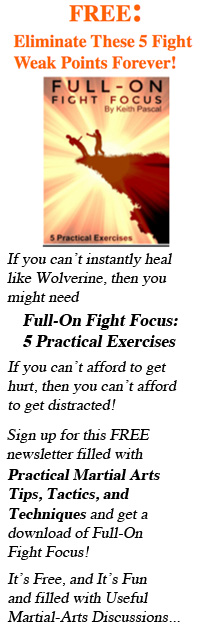Katana Sword Practice
How can I claim benefits of katana sword practice, when I seem to criticize formal forms and katas? Am I full of hot water? Or just full of it?
Discussing sword training is an excellent way to tackle the confusion around the benefits and detriments of kata practice….
Katas and Forms Debate
First, the reason that I poo poo kata practice is purely from a practical-application point of view. I write about practical self-defense.
And I write for people who aren’t necessarily into the historical aspects of a martial art. They want hard-hitting, efficient and effective, fighting methods. Period.
With the above in mind, I feel that forms practice is not your best use of time. You should practice timing and distance, reaction and response, and so forth.
So, does this include katana swords practice?
Katana Swords Training
If you are going to be an expert in Japanese swords, then you really should know some formal kata, for demonstration purposes, of course. I suggest something flashy and precise that solidifies your status as an authority 🙂
Seriously, katana swords don’t fall into my condemnation of forms practice. Why? Because I don’t think it’s very practical to carry around a samurai sword, wherever you go.
It’s not a very practical weapon in today’s society. So, if you are practicing this type of weapon’s training, then it’s probably for competition or some other reason. You aren’t doing it to perfect the best street-fighting methods on the block.
Sword Practice: Making It Useful
Did you know that I still practice techniques with a katana blade?
The difference is that I don’t practice a formal set of moves.
Note: At first, a form is a good way to learn technique, but at some point, you have to leave the formality behind and learn to flow … respond and react.
I love to take a sword out in the backyard, with no pets around, and do some free-form shadow boxing. As I move through our forest-like yard, I vary my techniques. A high shot around the tree, low, across the “knees” as I approach the Rhododendron.
And one of my favorite activities is fighting blackberry bushes with one of my cheaper machete-turned-katanas. I get to chop high and low, twist and turn, and practice every variation on sword technique.
But be careful … those blackberry vines have resilient, bounce-back power. One time, I swing, the sword connected and bounced, and the tip sunk into my calf of my right leg. 20 years later and I still have the scar.
Pardon the overused pun, but “the point” is that I do get some benefit from this shadow-sword-sparring. And no, I don’t think I’ll have my trusty machete with me most of the time. But the reactions, moving, imagined responses, and open-response techniques really do help in your martial proficiency.
Thoughts?
Tags: forms and kata debate, katana sword practice, katana swords



I think that would work, Keith. I started studying escrima about 3 weeks ago, and my instructor has me do drills with one stick, two sticks, no sticks, or a knife, to demonstrate how it is all applicable, regardless of situation. So, if I find myself with a broom handle nearby, that could be used, or not.
Good luck with the escrima. Less than 3 feet away form where I am typing, there are a set of sticks that a customer from the Philippines sent me — beautiful, dark hardwood.
Translation … I still practice some of the drills that you mentioned … one stick, two stick, no stick, etc.
Keith
Sword practice, free form, is definitely the way to demonstrate knowledge of sword techniques. I agree that “the reactions, moving, imagined responses, and open-response techniques really do help in your martial proficiency.” Nunchakus free form, also lends itself to martial proficiency. When practicing free-form nunchakus techniques, I also need to be aware of the bounce-back power. Free-form practice with sword or nunchaka is the best way to polish techniques.